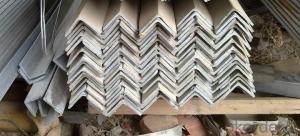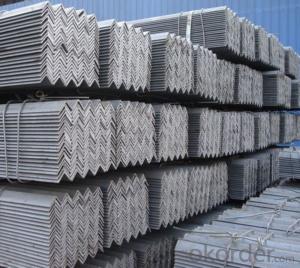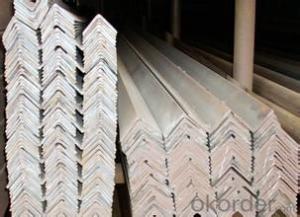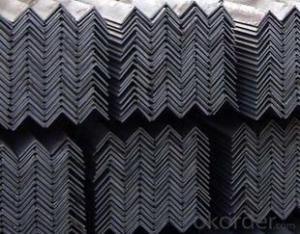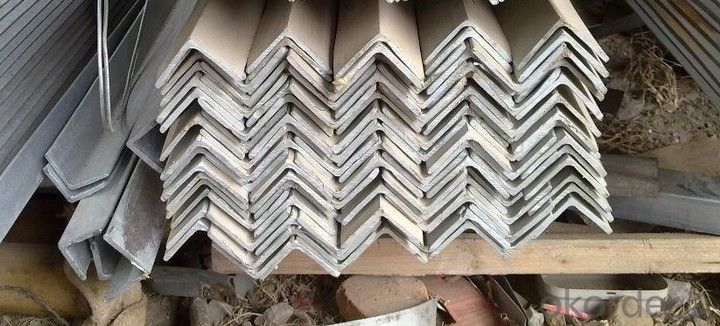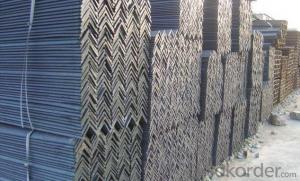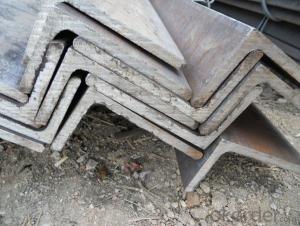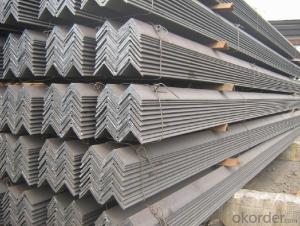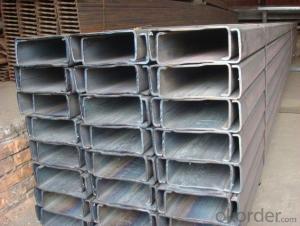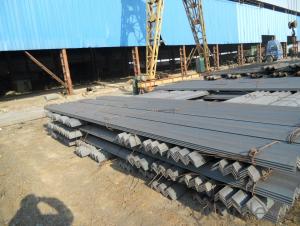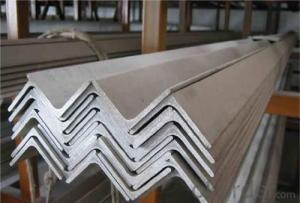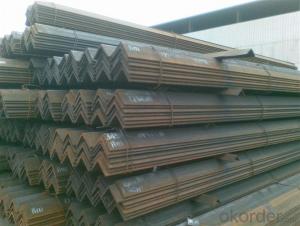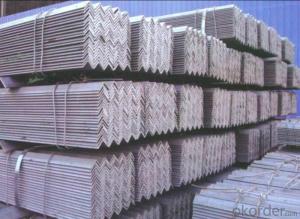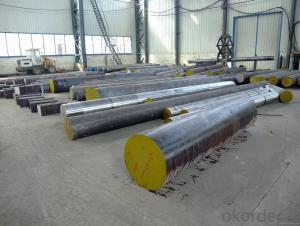Mild stainless steel angle for construction
- Loading Port:
- Tianjin
- Payment Terms:
- TT OR LC
- Min Order Qty:
- 10000 m.t.
- Supply Capability:
- 2000000 m.t./month
OKorder Service Pledge
OKorder Financial Service
You Might Also Like
Specification
Product Description:
OKorder is offering mild stainless steel angle for construction at great prices with worldwide shipping. Our supplier is a world-class manufacturer of steel, with our products utilized the world over. OKorder annually supplies products to European, North American and Asian markets. We provide quotations within 24 hours of receiving an inquiry and guarantee competitive prices.
Product Applications:
Mild stainless steel angle are ideal for structural applications and are widely used in the construction of buildings and bridges, and the manufacturing, petrochemical, and transportation industries.
Product Advantages:
OKorder's Steel angle are durable, strong, and resist corrosion.
Main Product Features:
· Premium quality
· Prompt delivery & seaworthy packing (30 days after receiving deposit)
· Corrosion resistance
· Can be recycled and reused
· Mill test certification
· Professional Service
· Competitive pricing
Product Specifications:
Detailed Informaion
Name | Equal/Unequal Angle Steel Bar |
Shape | Equal/Unequal Angle |
Standard | GB/ASTM/SAE/AISI/DIN/JIS/EN/BS |
Surface Treatment: | Black/Peeling/Polished/Machined |
Delivery Condition: | Hot Rolled or Forged/Peeled or Black Surface |
Test | SGS/UT 100% Elements Testing |
Certificate: | ISO/Mill Certificate |
Service: | 24 hours online service / |
more than 20 years trading and manufacture | |
Quality Assurance: | the third party inspection, such as SGS, BV, TUV…etc. is acceptable |
Packaging Details: | Seaworthy Packaging or as per customer's packing instruction |
Specification
hot rolled equal angle steel | hot rolled unequal steel angle |
specification(mm) | specification(mm) |
20*3/4 | 26*16*3/4 |
25*3/4 | 32*20*3/4 |
30*3/4 | 40*25*3/445*28*3/4 |
36*3/4/5 | 50*32*3/4 |
40*3/4/5 | 56*36*3/4/5 |
45*3/4/5/6 | 63*40*4/5/6/7 |
50*3/4/5/6 | 70*45*4/5/6/7 |
56*3/4/5/8 | 75*50*5/6/8/10 |
63*4/5/6/8/10 | 80*50*5/6/7/8 |
70*4/5/6/7/8 | 90*56*5/6/7/8/ |
75*5/6/7/8/10 | 100*63*6/7/8/10 |
80*5/6/7/8/10 | 100*80*6/7/8/10 |
90*6/7/8/10/12 | 110*70*6/7/8/10 |
100*6/7/8/10/12/14/16 | 125*80*7/8/10/12 |
110*7/8/10/12/14 | 140*90*8/10/12/14 |
125*8/10/12/14 | 160*100*10/12/14/16 |
140*10/12/14/16 | 180*110*10/12/14/16 |
160*10/12/14/16 | 200*125*12/14/16/18 |
180*12/14/16/18 |
|
200*14/16/18/20/24 |
|
Company Information
CNBM International Corporation is the most import and export platform of CNBM group(China National Building Material Group Corporation) ,which is a state-owned enterprise, ranked in 270th of Fortune Global 500 in 2015.
With its advantages, CNBM International are mainly concentrate on Cement, Glass, Iron and Steel, Ceramics industries and devotes herself for supplying high quality series of refractories as well as technical consultancies and logistics solution.
Packaging & Delivery
Packaging Detail | Sea worthy packing /as per customer's packing instruction |
Delivery Detail | 15 ~ 40 days after receiving the deposit |
Product Show
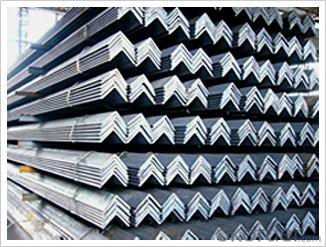
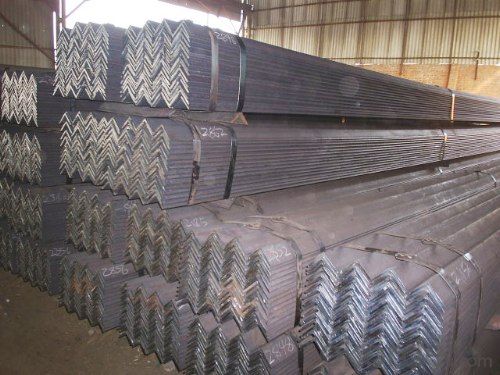
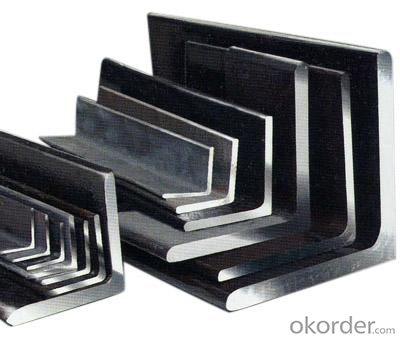
FAQ:
Q1: What makes stainless steel stainless?
A1: Stainless steel must contain at least 10.5 % chromium. It is this element that reacts with the oxygen in the air to form a complex chrome-oxide surface layer that is invisible but strong enough to prevent further oxygen from "staining" (rusting) the surface. Higher levels of chromium and the addition of other alloying elements such as nickel and molybdenum enhance this surface layer and improve the corrosion resistance of the stainless material.
Q2: Can stainless steel rust?
A2: Stainless does not "rust" as you think of regular steel rusting with a red oxide on the surface that flakes off. If you see red rust it is probably due to some iron particles that have contaminated the surface of the stainless steel and it is these iron particles that are rusting. Look at the source of the rusting and see if you can remove it from the surface.
- Q: What are the different methods of surface protection for steel angles?
- Steel angles can be protected using various methods, each with its own pros and cons. 1. Painting: A common approach is to apply a layer of paint, creating a barrier between the steel and its surroundings. Paint offers both aesthetic appeal and corrosion resistance. However, it may need regular maintenance and can chip or peel over time. 2. Galvanization: This involves coating the steel angle with a layer of zinc, which acts as a protective barrier against corrosion. Galvanization can be achieved through hot-dip or electro-galvanizing methods. Hot-dip galvanizing immerses the steel angle in molten zinc, while electro-galvanizing uses an electrical current to deposit zinc. Galvanized steel angles are highly rust-resistant and provide long-lasting protection. 3. Powder coating: This dry finishing process involves electrostatically applying a fine powder to the steel angle, which is then cured under heat to form a durable coating. Powder coating offers excellent protection against corrosion, impacts, UV rays, and chemicals. It also provides a wide range of color options and a smooth, attractive finish. However, it can be costlier and requires specialized equipment. 4. Epoxy coating: Epoxy coatings are made from epoxy resins and offer high resistance to chemicals, impacts, and abrasions. They provide a tough, glossy finish that can withstand harsh environments. Epoxy coatings are typically applied using a two-part system, mixing a resin and a hardener before application. While they offer excellent protection, they can be more expensive and time-consuming to apply. 5. Metal plating: This involves covering the steel angle with a layer of metal such as chrome, nickel, or zinc. Metal plating offers a decorative finish and protection against corrosion. Electroplating and electroless plating are the two methods used. Electroplating utilizes an electrical current to deposit a thin metal layer, while electroless plating achieves plating through a chemical reaction without requiring electricity. Metal plating enhances the appearance and durability of steel angles, but may be less effective in highly corrosive environments.
- Q: Can steel angles be used for manufacturing playground equipment?
- Yes, steel angles can be used for manufacturing playground equipment. Steel angles provide strength and stability, making them suitable for constructing various playground structures such as slides, swings, and climbing frames.
- Q: What are the different methods of cutting steel angles?
- There are several methods used for cutting steel angles, depending on the specific requirements and resources available. Some of the commonly used methods include: 1. Saw cutting: This method involves using a circular saw or bandsaw equipped with a metal cutting blade. It provides a clean and precise cut, especially for smaller angles. 2. Laser cutting: Laser cutting is a highly accurate and efficient method that uses a focused laser beam to melt or vaporize the steel angle. It is ideal for complex shapes and intricate designs. 3. Plasma cutting: Plasma cutting utilizes a high-temperature plasma arc to melt the metal and blow away the molten material. It is a versatile method suitable for cutting thicker steel angles. 4. Waterjet cutting: Waterjet cutting involves using a high-pressure jet of water mixed with abrasive particles to erode the steel angle. This method is excellent for cutting thick angles and creating intricate patterns. 5. Shearing: Shearing is a process that involves using a machine with a sharp blade to cut through the steel angle. It is commonly used for straight cuts and is suitable for thinner angles. 6. Abrasive cutting: Abrasive cutting utilizes a rotary wheel embedded with abrasive particles to cut through the steel angle. It is a relatively fast and cost-effective method, but it may result in a rougher cut surface. 7. Flame cutting: Flame cutting, also known as oxy-fuel cutting, uses a mixture of fuel gas and oxygen to create a high-temperature flame, which melts the steel angle. It is suitable for cutting thicker angles but may result in a heat-affected zone. Each cutting method has its advantages and limitations, and the choice of method depends on factors such as the angle's thickness, complexity of the cut, desired precision, and available equipment. It is essential to consider safety precautions and choose the most appropriate method to ensure a successful and efficient steel angle cutting process.
- Q: Are steel angles resistant to extreme weather conditions?
- Yes, steel angles are highly resistant to extreme weather conditions. They have excellent durability and can withstand harsh weather elements such as heavy rain, strong winds, and extreme temperatures without any significant damage or deterioration.
- Q: Are steel angles suitable for manufacturing shelving units?
- Yes, steel angles are highly suitable for manufacturing shelving units due to their strength, durability, and versatility. Steel angles provide excellent support and stability, making them ideal for supporting heavy loads and maximizing storage space. Additionally, their rigid structure allows for easy customization and installation, making them a popular choice in the manufacturing of shelving units.
- Q: Can steel angles be used for framing or supporting exterior façade elements?
- Yes, steel angles can be used for framing or supporting exterior façade elements. Steel angles provide structural support and stability, making them suitable for framing and supporting various components of an exterior façade, such as windows, doors, cladding, and signage. They offer strength, durability, and versatility, making them a popular choice in architectural and construction applications.
- Q: Can steel angles be used in the construction of hotels?
- Yes, steel angles can be used in the construction of hotels. Steel angles are commonly used in construction for their strength and versatility. They can be used for structural support, framework, and reinforcement in various applications, including hotels. Their ability to withstand heavy loads and provide stability makes them a suitable choice in hotel construction projects.
- Q: How do steel angles contribute to the sustainability of a project?
- Steel angles contribute to the sustainability of a project in several ways. Firstly, they are made from recycled steel, reducing the demand for new raw materials and promoting a circular economy. Secondly, steel angles have a high strength-to-weight ratio, allowing for lighter and more efficient structural designs, which in turn reduces the amount of steel required and minimizes the carbon footprint of the project. Lastly, steel angles are durable, resistant to corrosion, and have a long lifespan, ensuring the longevity and sustainability of the structure they support.
- Q: What are the different types of steel angles connections?
- Construction and engineering projects utilize various steel angle connections. Some commonly used types are: 1. Welded Connection: Skilled welders join the angles using welding techniques, creating a robust and rigid connection. However, this method requires time and expertise. 2. Bolted Connection: Bolts, nuts, and washers connect the angles, allowing for easy disassembly and modification. It is popular for temporary structures or situations requiring future changes. Additional reinforcement like gussets or plates can be used. 3. Riveted Connection: In older steel structures and bridges, riveting was commonly employed. Rivets, which are metal pins with a head, are hammered into pre-drilled holes to form a permanent connection. 4. Clip Angle Connection: Clip angles, small steel angles, are bolted or welded to the main angles, providing additional support and reinforcement. This enhances the strength and stability of the primary connection. 5. Pinned Connection: Pinned connections enable rotational movement between angles, allowing for flexibility and load redistribution. A pin or bolt passes through holes in the angles, enabling free rotation. 6. Gusset Plate Connection: Gusset plates, flat steel plates, connect and reinforce the angles. They are typically bolted or welded to the angles, adding strength and stability to the connection. The selection of a steel angle connection depends on factors such as load-bearing requirements, structural design, installation ease, and future modifications. Each type has its own advantages and disadvantages, and engineers carefully choose the most suitable connection based on project-specific needs.
- Q: How do you determine the appropriate length of a steel angle for a specific application?
- When determining the appropriate length of a steel angle for a specific application, there are several factors to consider. To begin with, it is necessary to assess the structural requirements of the application. This involves analyzing the loads and forces that the steel angle will experience. It is important to determine the maximum load capacity that the steel angle needs to support and ensure that its length can adequately distribute the load without excessive deflection or failure. Next, the dimensions and layout of the application should be taken into account. The available space should be measured and the fit of the steel angle within the overall structure should be determined. Any constraints, such as adjacent components or obstructions, that may impact the length of the steel angle should also be considered. Furthermore, consulting relevant engineering and construction standards is essential. These codes and guidelines provide recommended design values and specifications for steel angles based on their intended use. They can assist in determining the appropriate length based on the application requirements and the material properties of the steel angle. Additionally, it is important to consider the fabrication and installation process. The manufacturing capabilities and limitations should be evaluated, along with any specific requirements for joining or fastening the steel angle. This will help determine if the desired length is feasible and practical in terms of fabrication and installation methods. Lastly, seeking advice from a structural engineer or a qualified professional in the field is advisable. They can provide expert guidance and calculations based on the specific application, ensuring that the chosen length of the steel angle meets all necessary safety and performance requirements. In conclusion, determining the appropriate length of a steel angle for a specific application involves analyzing the structural requirements, considering the dimensions and layout, referring to relevant standards, evaluating fabrication and installation processes, and seeking professional guidance when required.
Send your message to us
Mild stainless steel angle for construction
- Loading Port:
- Tianjin
- Payment Terms:
- TT OR LC
- Min Order Qty:
- 10000 m.t.
- Supply Capability:
- 2000000 m.t./month
OKorder Service Pledge
OKorder Financial Service
Similar products
Hot products
Hot Searches
Related keywords
